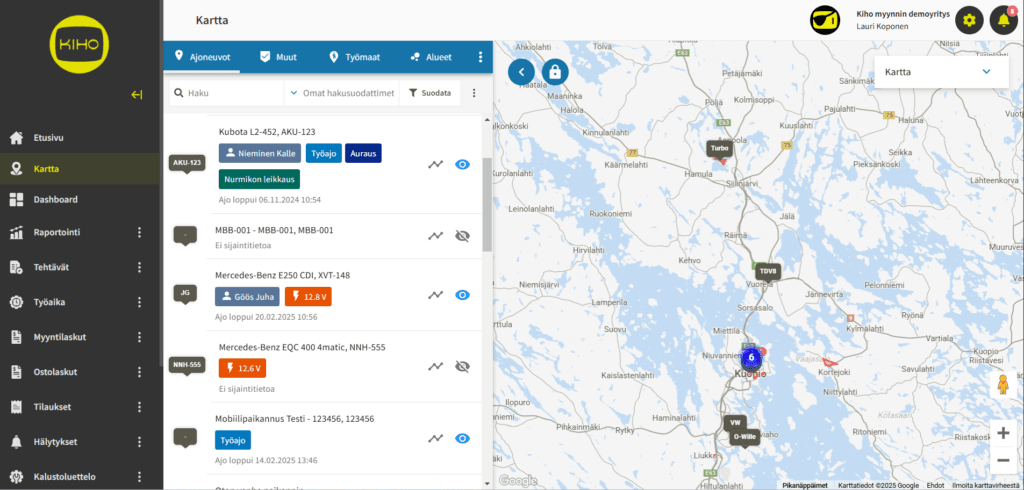Modules
Telematics
Efficient use of company vehicles and machinery doesn’t improve through guesswork. It requires accurate monitoring and analysis to support corrective action. Without real-time data on fleet movements, utilisation rates, and performance, a company lacks a clear picture of how its resources are actually being used.
With Kiho’s Telematics module, you get tracking, driving logs, and comprehensive reporting in one place. This allows you to optimise fleet usage, monitor work in specific areas, and cut unnecessary costs.

Telematics Makes Fleet Usage and Efficiency Easy to Monitor
Telematics isn’t just about tracking vehicle locations—it’s a data-driven management tool that helps a company answer important questions:
- How can downtime be reduced and productivity improved?
- How efficiently is the fleet being used?
- Where are the vehicles and machines moving, and how are they being used?

All vehicle and machinery data in one system
Kiho’s telematics includes all the features of a driving log but also delivers in-depth analytics and reporting on fleet usage. This supports fleet management optimisation, more efficient resource use, and improved business profitability.
With telematics, you gain access to area management and area reporting, making it easy to monitor and enhance tasks such as sanding and ploughing, assess site-specific profitability, and evaluate performance across different work areas. This helps allocate resources where they’re needed and ensures tasks are completed efficiently.
The system also generates comparative reports for vehicles and drivers, allowing the company to analyse different driving styles, fuel consumption, and work efficiency. This supports better driver-specific training and smarter fleet optimisation.
In addition, utilisation reporting provides a real-time overview of fleet activity. The company can see which vehicles and machines are in use, which are standing idle, and how much fleet is actually needed. This leads to smarter investment decisions and reduced unnecessary fleet costs.

How Kiho’s Telematics Works in Practice
1.
Real-Time Tracking and Driving Log
The system automatically records the movements of vehicles and machines, creating a complete driving log.
Example: A transport company’s vehicles can be tracked in real-time, allowing management to monitor where the vehicles are moving and whether work time planning is efficient.
2.
Area Management and Reporting
All work areas can be defined in the system, allowing tasks such as sanding, plowing, and maintenance work to be reported accurately.
Example: Management can receive a report for a selected period, showing which fleet operated in the area and the lengths of driving performances. This information can be used for billing or, for example, resolving complaints.
3.
Fleet Utilisation Monitoring
The system analyses how efficiently vehicles and machines are used and which units are standing idle.
Example: A construction company sees that some machines have been idle for weeks without use, allowing the company to rent out the extra fleet or optimise fleet allocation across different sites.
4.
Driver and Vehicle Comparative Reporting
The system enables driver-specific analysis, allowing comparisons such as kilometres driven, driving style, and working hours.
Example: The company notices that some drivers operate significantly more economically than others. With this insight, it can offer targeted training to improve energy efficiency across the entire fleet.
Enhance the System with Kiho Modules
Kiho’s telematics can be integrated with Fleet Management, Invoicing, and BI Reporting, allowing vehicle data to be utilised more broadly in business optimisation.
Additionally, the system can be connected to area-based work management, work time tracking, and maintenance management, enabling comprehensive control over operations.
Why is telematics a smart choice?
Without accurate fleet tracking, a company risks losing money due to inefficient use, unnecessary maintenance, and uncontrolled costs. Telematics provides transparency, efficiency, and control, helping businesses make better decisions about vehicle and machinery usage.
When a company knows exactly how its fleet is utilised, it reduces waste, optimises routes, enhances economical driving practices, and addresses issues long before they escalate into significant expenses.
No more guesswork—just precise information and smarter decisions


